How to Grow Potatoes in Containers
This post may contain affiliate links, which means that I may receive a commission if you make a purchase using these links. As an Amazon Associate I earn from qualifying purchases.
If you don’t have room in your garden to plant potatoes, or if you have no garden at all, you can grow potatoes in containers. Here are some tips for growing potatoes in pots, grow bags, and buckets.
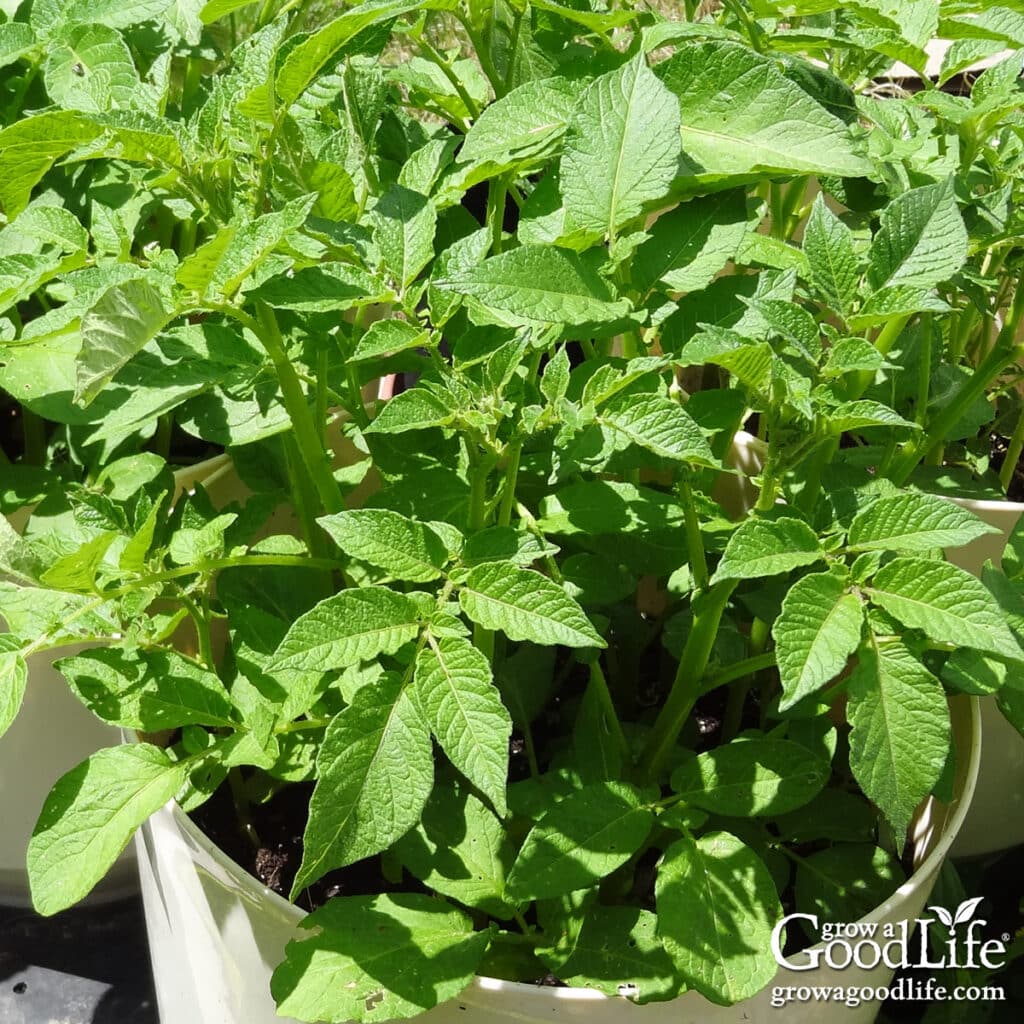
There is nothing like the flavor of freshly dug potatoes. Potatoes are easy to grow and provide a nutritious addition to meals. According to the United States Potato Board, one medium-size potato is only 110 calories and provides a healthy source of potassium, iron, vitamin C, and vitamin B6. Consuming potatoes with the skins on contributes 2 grams of fiber—all the more reason to grow your own organic potatoes and avoid the chemicals sprayed on commercial potatoes.
You don’t have to devote precious garden space to grow potatoes. Potatoes can be grown on a small scale in all types of containers in any area that receives at least 6 to 8 hours of direct sun. Consider trying to grow potatoes in pots, grow bags, buckets, or other containers.
Benefits of Growing Potatoes in Containers
1. No soil contamination: Since you use fresh potting soil, you don’t have to worry about crop rotation, soil-borne diseases, weed seeds, or pests left over from the previous growing season.
2. Containers can be placed anywhere: The containers are easy to care for and can be placed on your patio, balcony, or any spot in your yard that receives full sun.
3. Easy harvest: Harvesting the potatoes is easier than digging, and there is less chance of damaging the tubers with a digging fork or shovel. Instead of digging, you just dump out the pot, and there they are!
4. Potatoes are protected from soil pests: The container shields the potatoes from rodents and other pests in the garden soil. If you have a problem with moles, gophers, voles, or chipmunks tunneling through your garden and eating your tubers beneath the soil, growing potatoes in containers is your solution. It also protects from wireworms, grubs, and other pests.
Types of Potatoes Ideal for Growing in Containers
Early potato varieties are perfect for growing in containers because they mature quickly and produce their crop all at once.
- Early potatoes usually mature within 65 to 80 days, or you can harvest new potatoes in about 6 to 7 weeks from the planting date.
- Small, new potatoes have thin skin and a sweet flavor with a delicate texture.
- Some early varieties of potatoes include Chieftain, Dark Red Norland, Irish Cobbler, Sangre, Red Gold, and Yukon Gold.
Fingerling potatoes varieties are also suitable for growing in containers. They are small, 2 to 4 inches long varieties that are narrow, finger—or oblong-shaped.
- Colors range from red, orange, purple and white skin with orange, purple, yellow or white flesh.
- Their flavor is mild, nutty, and earthy, and the flesh has a firm and moist texture.
- Some fingerling potato varieties include AmaRosa, Banana, French Fingerling, Pinto, and Rose Finn Apple.
Tips for Growing Potatoes in Containers
If you plan to grow potatoes in containers, here are some tips to keep in mind to help your plants grow well and yield a good harvest.
Choose the Right Containers
The larger your container, the more room your plants have to stretch out their roots and form tubers. Consider the following:
Large Pots: Large pots and planters are ideal for growing potatoes. Select a container at least 16 inches in diameter and 16 inches (41 cm) high. You can plant 4 to 6 seed potatoes in this sized container. These 10-gallon nursery pots are perfect.
Grow Bags: Grow bags are made from fabric, which helps prevent over-watering and allows air to reach the roots. Grow bags tend to dry out quicker than other containers, so keep an eye on your plant’s watering needs. Consider these 5-gallon grow bags to grow 2 to 3-seed potatoes or these 10-gallon grow bags to plant 4 to 6-seed potatoes.
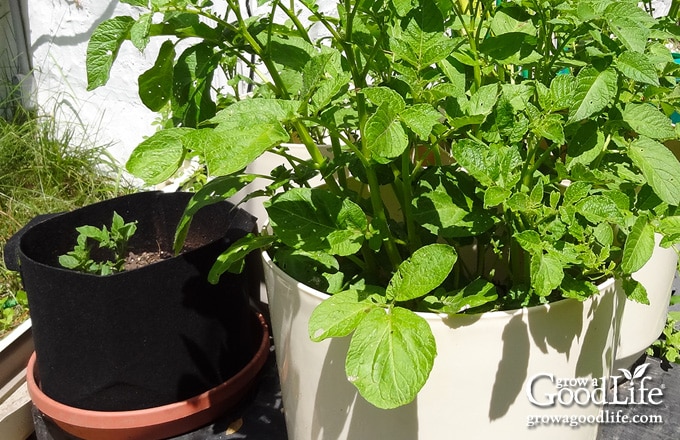
Large Buckets: Recycled food-grade 5-gallon buckets will also work well for growing potatoes. Drill holes in the bottom to allow drainage. You can plant 1 to 2 seed potatoes in 5-gallon buckets.
Self Watering Containers: Self-watering containers are an enclosed growing system that decreases moisture evaporation and offers a consistent water supply to your plants. They are the perfect solution for maintaining a consistent moisture level for your potato plants. Since the soil wicks water as needed, using self-watering containers helps eliminate over-watering and dry soil. You will need a deep container to grow potatoes. How to Build Your Own Self-Watering Planter.
Sourcing Seed Potatoes and Pre-Sprouting
Potatoes are grown from tubers rather than seeds, and each seed potato can sprout multiple plants that will grow tubers. Choose high-quality seed potatoes to ensure healthy growth and minimize the risk of diseases. Consider reputable garden centers, nurseries, or online suppliers when sourcing seed potatoes. I would avoid using grocery store potatoes. They are usually treated to prevent sprouting and won’t grow very well.
Consider pre-sprouting (chitting) for faster, uniform growth. Chitting, is a technique that encourages faster and more uniform growth. Check out this article to learn how to pre-sprout potatoes: Tips on Preparing Potato Seeds for Planting.
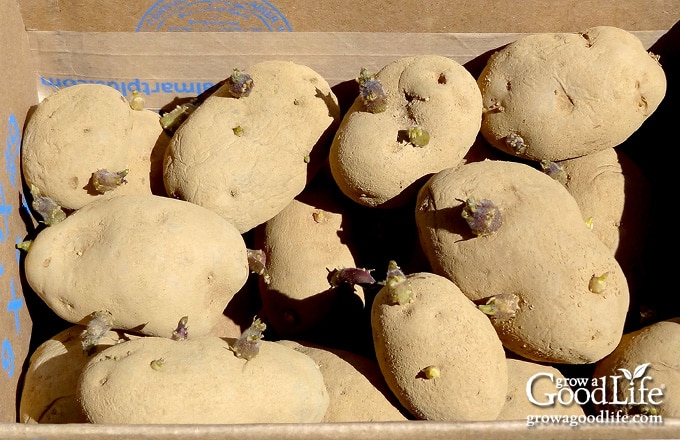
Use a Lightweight Soil Mix
A good all-purpose potting soil mix specifically made for containers will work very well for growing potatoes. Potatoes prefer slightly acidic soil. If you are mixing your own growing medium, a good mix is 1/3 good-quality finished compost, 1/3 vermiculite or perlite, and 1/3 coconut coir or peat moss.
Feed the Plants
Add an organic granular fertilizer, such as Plant Tone to the container at planting time. Once the plants emerge from the soil, feed the foliage every two weeks with a liquid organic fertilizer, such as fish emulsion. Spray the plants early in the morning to give the foliage time to absorb the nutrients and dry before the hot midday sun. Follow the instructions on the packages.
Water Well
Monitor soil moisture closely, especially in warm weather. The moisture requirements of potato plants grown above ground are greater than in the ground. Water evaporates quickly since the soil is not insulated, as well as the ground. The plants will stop growing if they become dry or overheated.
Check the containers frequently by sticking your finger in the soil. Water your pots if the top two inches of the soil feels dry. Water deeply until the excess water drains out the bottom holes so the moisture reaches the roots at the bottom of the container.
Keep the Tubers Covered
Prevent green skin on potatoes by covering them with soil or heavy mulch to block sunlight. When exposed to direct sunlight during growth, potatoes develop green skin areas, which are toxic and should be trimmed away. Protect your potatoes from forming green skin by protecting them with soil or mulching heavily so no light reaches the tubers.
Grow Potatoes in Full Sun
Potatoes thrive in full sun and need 6 to 8 hours of sunlight daily. However, they are a cool-season crop that does not do well in high temperatures. As the roots are not insulated in the ground, the plants may stop growing once temperatures exceed 80°F. If the weather in your area is warm, try to place your containers in an area that receives morning sun but is partially shaded during the afternoon.
How to Plant Potatoes in Containers
By following these steps, you can successfully grow potatoes in containers, even in limited garden space or without a traditional garden bed.
Step 1: Preparing the Containers
It is important to make sure that your plant containers have enough drainage holes at the bottom to allow excess water to drain out. Drill more holes if needed.
Add about 6 inches of potting mix to the bottom of each growing container, mix in the fertilizer, and water thoroughly to dampen the soil.
Step 2: Planting the Seed Potatoes
Space the seed potatoes evenly, about 6 inches (15 cm) apart, on top of the soil layer. If the tubers have sprouts, make sure these are facing up. Gently press them into the soil and cover them with another layer of soil approximately 6 inches (15 cm) deep. Water thoroughly until the soil is evenly moist but not waterlogged.
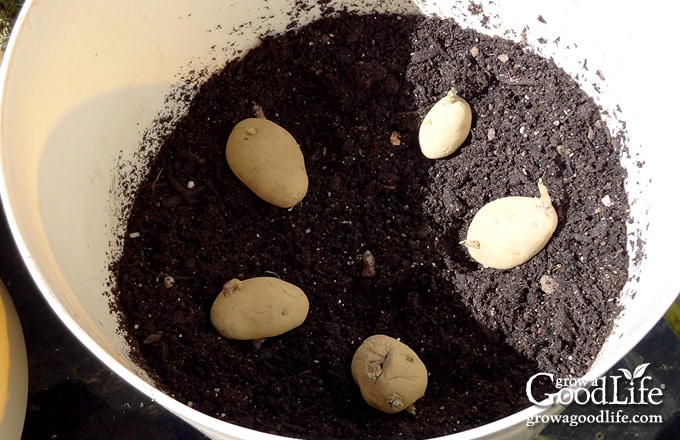
Place the containers in an area providing full sun exposure for at least 6 to 8 hours daily. Continue to water the plants regularly, ensuring the soil remains moist but not soggy.
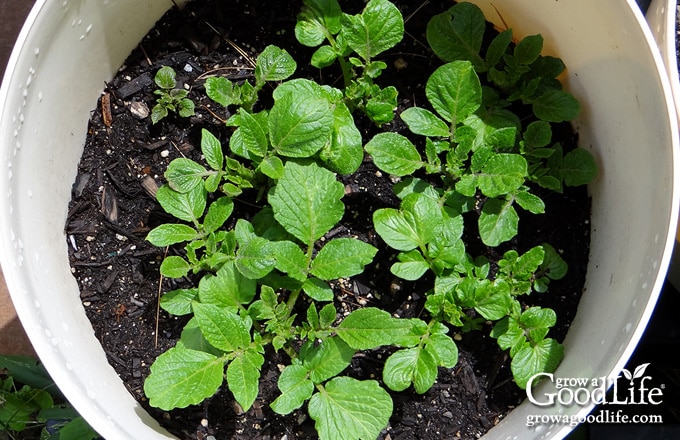
Step 3: Hilling the Soil
As the potato plants grow and reach about 6 inches (15 cm) in height, begin the hilling process. Gently mound additional soil around the stems, covering about half of the exposed foliage.
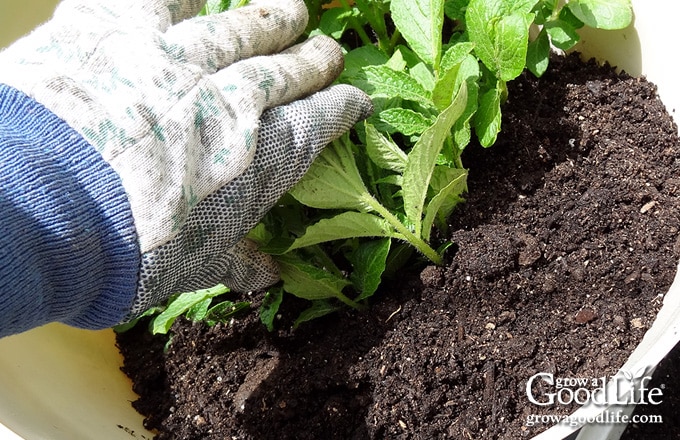
Repeat this process every two weeks or so until the container is nearly full. Then add a layer of mulch to help hold in moisture.
Water as needed, and monitor the plants as they grow. They will begin to flower, indicating that tubers are forming underground.
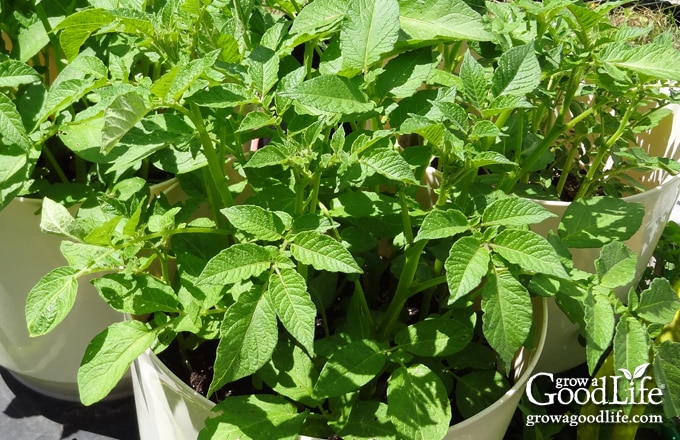
Step 4: Harvesting
As the potato plants near the end of their growth cycle, their foliage will start to turn yellow and wither. At this point, stop watering and allow the foliage to die back.

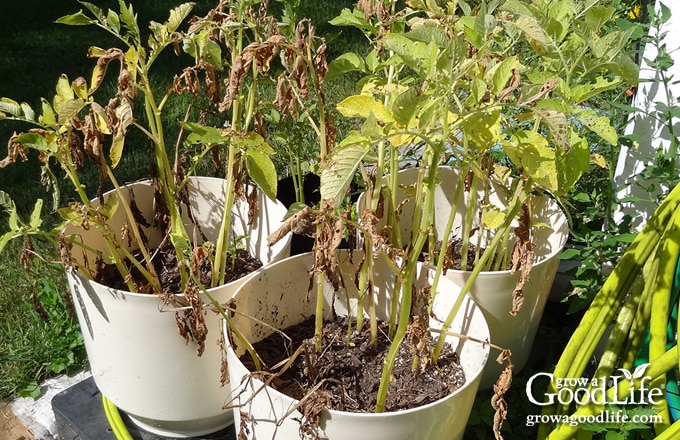
Once the foliage has died back, it’s time to harvest. Carefully tip the container over into a wheelbarrow or onto a tarp, and gently sift through the soil to reveal the potato tubers.
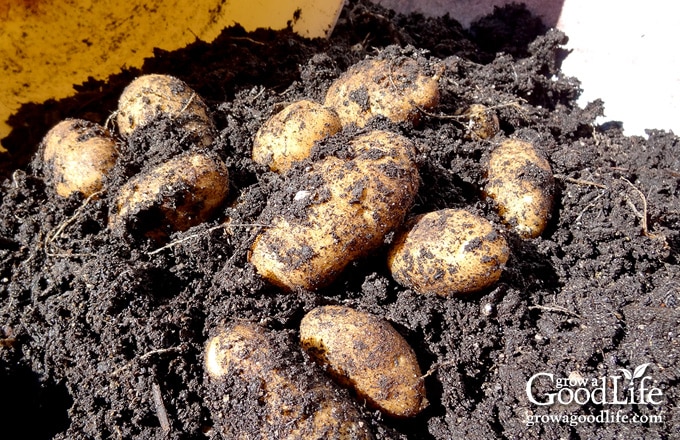
I hope I have encouraged you to start growing potatoes in containers today and savor the taste of homegrown goodness right at your doorstep.
With some preparation, care, and patience, you can enjoy the satisfaction of harvesting your homegrown potatoes, freshly dug from the comfort of your own container garden.
You May Also Like:
- Sourcing Seed Potatoes for the Backyard Garden
- 8 Great Tips for Growing Potatoes
- 6 Different Ways of Growing Potatoes
- 5 Steps to Storing Potatoes for Winter
Want to Learn How to Grow Potatoes?
You will find everything you need to start growing potatoes in my PDF eBook, Grow a Good Life Guide to Growing Potatoes. Whether you are striving for a few gourmet fingerling potatoes or a large crop for winter food storage, this guide will show how you can grow your own, organic, homegrown potatoes.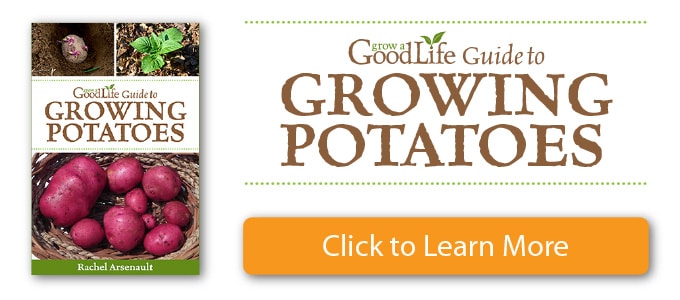

Thank you for this article. I am new to gardening. How do you know when buying the soil, that it has all the nutrients needed for potatoes? Also, what is a good mulch?
Thank you
Juanita, Purchased soil may contain some nutrients, but it will be depleted quickly as the plants use it, and washed out from watering. You will need to feed with additional all-purpose fertilizer to nourish the plants and keep them healthy.
It’s Mid July and I’d like to plant potatoes to harvest for the Fall. Day time temperatures here reach 90-105 average in August. Can I plant them in bags and move the bags to shade in the afternoons? They might not get a full 8 hours of sun if I do move them to a cooler spot. I am in Northern Nevada. Thanks!
Karen, Potatoes do like cooler soil. You could try moving them daily to the shade. Potatoes will grow in partial shade too, just at a slower rate and will produce smaller potatoes. With that being said, I would give it a try. Also consider growing potatoes in the cooler weather of fall for a winter harvest.
I live in the Nevada desert. It is however iwinter here and it’s quite cold. Am I allowed to leave these potatoes in the bags outside in full sun even though it’s cold? Sometimes freezing. Or should I bring them in with a grow light? The house is pretty hot though with the fireplace
Maria F, Potatoes cannot survive frost or freezing temperatures. I would bring them in if you can, or harvest now.
I have planted some potatoes in a 5 gallon bucket, they have come up but are tall and langly with leaves at top and some new sprouts on leaves… is this normal … they are not bushy like when planting in a garden. any suggestion?
Barbara, It sounds like the plants need to be hilled up.
Thank you for such an informative article! Can potatoes be grown indoors during winter months with grow lights? If so, what is the optimal temperature range. Can potted potatoes be grown in a mix of coco coir and peat moss without soil?
Sophia, It would be fun to try growing potatoes indoors. However, I have never done it so I can’t provide advice. Let me know if you try it. You could try just a coco coir and peat moss mix, but there are no nutrients and will dry out quicker. That’s why I recommend 1/3 finished compost, 1/3 vermiculite or perlite, and 1/3 coconut coir or peat moss. Potatoes are heavy feeders so they would need some organic fertilizer mixed in.
I am currently growing potatoes in grow bags for the first time and cant seem to get a for sure as to when they are ready. You say the foliage will begin to yellow, will this be a noticable change in color all over the plant or a random leaf or two?
Lacie, Once the plant’s foliage dies, the potatoes are finished growing beneath the soil. You can harvest small potatoes sooner. Just dig down beneath the soil to see what you can find.
Do u close the top of the bag after u plant
Lani, No, you keep the top of the grow bags open just like a pot.
I have never grown potatoes but I have some experience in growing tomatoes and some widely used herbs in Indian kitchens like cilantro, mint and basil. Your article has given me some serious motivation about trying my hands with potatoes. Keeping my fingers crossed. Thanks Rachel.
I grow my potatoes in large containers and it works very well. I went to a gardening workshop last week. They said you can reuse your potato potting soil for other plants without a problem except for tomatoes, eggplant and peppers (because they are in the same nightshade family). – Margy